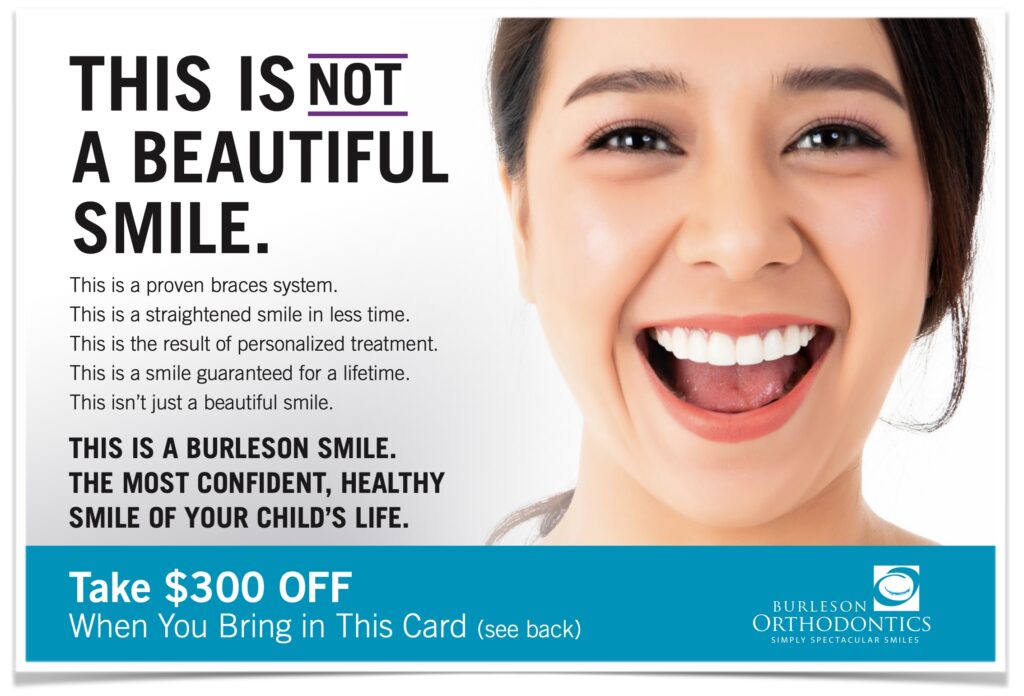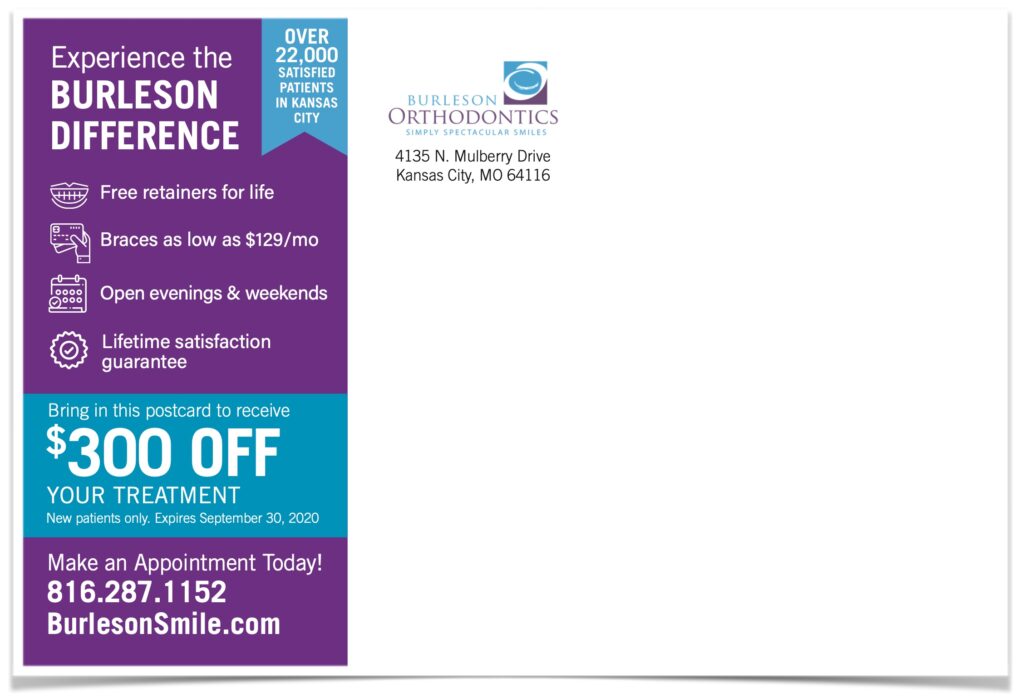One of our top members at Burleson Seminars recently asked me if I had a "bulletproof checklist" for dental and orthodontic marketing campaigns. I've probably given a dozen lectures on the topic around the world so my answer was, "Sure! Let me see what I can find." I jumped down the Dropbox rabbit hole, looking for the key principles from a handful of lectures and seminar programs.
At the end of the day, I found twelve "laws" of direct response marketing. Does this mean there are only twelve? Of course not. Dare I suggest you must consider my strategies and principles as never-to-be-violated laws? Meh. Never say never. I've mailed millions of pieces of direct mail over the last two decades, probably more than any other orthodontist on the planet, but I'm not in charge of a $100 million annual advertising budget, so take my advice for what it is. Like a used Ford Pinto in the pouring rain, when all other alternatives have two wheels or hooves, I might be the best option you've got.
Bottom line: If you locked me in a room and forced me to come up with more than twelve laws of direct response marketing, I'm sure I could think of a few more, but this is a really good start. I ran it by a handful of our top docs at Burleson Seminars and they were either feeling generous or agree with me (maybe they were just super busy?), because their feedback was extremely positive.
Why a Checklist?
Before you approve a marketing campaign and send it out into the world to see what results it can fetch, go through this checklist. Like a pilot's preflight routine, some of these might seem incredibly simple and redundant. However, it's very easy to forget a critical item on the checklist. Ask me how I know. I once sent out a direct mail campaign without any method of response. Just our logo and address. No phone number. No website. Nothing. Just a big fat offer and call to action but nowhere for the prospect to go. I sounded like Homer Simpson when I saw the overages come back in print. "D'oh!"
It's really easy to get excited about a new marketing campaign and overlook one of these critical elements. Often, the checklist will prompt you to improve the marketing piece, making it stronger and boosting your odds for an increased response rate.
If I had a magic wand and could cure the most-critical error in dental and orthodontic marketing—and this might sound aggressive, but it is not untrue—most dental and orthodontic advertising campaigns do not have a message worth marketing. Just because you're a dentist or orthodontist and you enjoy helping people and working on teeth, the universe doesn't really give a hoot.
Everyone walks around listening to the radio station WIIFM (What's In It For Me?). You must have a really good reason why you're interrupting the consumer with your marketing message. You must deliver value and never bore the reader to death.
"Make it simple. Make it memorable. Make it inviting to look at. Make it fun to read."
— Leo Burnett
If you'll pump the brakes before each and every marketing campaign, run through this checklist and give the tool to your marketing team, I promise you'll be a lot less likely to make the same mistakes I've made. It will only take you 2 minutes and 30 seconds to go through the list. Easy-peasy. Warren Buffett and his business partner, Charlie Munger have a knack for learning the life-lessons of others by reading voraciously. Consider this one such life-lesson from yours truly to the dental and orthodontic profession. You're busy and have more important things to do. You don't need to acquire the same scar tissue that I've accumulated over the years. Let my bumps, scrapes and bruises be enough for the both of us.
Dustin Burleson's Twelve Laws of Direct Response Marketing
- Headline: Does the headline grab attention, communicate the main benefit of the product/service, and/or create a sense of urgency?
- Offer: Is the offer clear, specific, and compelling? Does it address a specific pain point or desire that the target audience has?
- Call to Action (CTA): Is the CTA prominent and clear? Does it urge the audience to take immediate action, and is it easy to complete the desired action?
- Unique Selling Proposition (USP): Does the marketing piece clearly articulate what sets the product or service apart from competitors?
- Benefits: Does the marketing piece outline the benefits of the product or service in a clear and compelling way, and does it explain how those benefits will address the target audience's pain points or desires?
- Social Proof: Does the marketing piece include social proof, such as customer testimonials or reviews, that demonstrates the product or service's effectiveness?
- Guarantees: Does the marketing piece include any guarantees, such as a money-back guarantee, that will reduce the target audience's perceived risk?
- Personalization: Does the marketing piece use personalization, such as addressing the target audience by name, to create a sense of connection and relevance?
- Clarity: Is the messaging clear and easy to understand? Does it avoid jargon or technical language that may confuse the target audience?
- Design: Does the design of the marketing piece reinforce the messaging and make it easy to read and understand? Is it visually appealing and attention-grabbing?
- Testing: Has the marketing piece been tested to ensure it is effective? Have different variations of the piece been tested to optimize the messaging, design, and CTA?
- Method of Response: Are there multiple ways for the prospect to respond to the offer? Have you tested different response methods and measured response rate? Never assume. Always test.
Here are some methods of response to consider for each campaign:
Online: Provide a website or landing page where prospects can respond online by filling out a form, making a purchase, or requesting additional information. These landing pages or URLs should be unique to the piece and trackable.
Phone: Include a phone number that prospects can call to place an order, speak with a representative, or get more information. This number should be a call-tracking number.
Mail: For some clients and industries, especially when using a product catalog, provide a business-reply card that prospects can use to mail in their order or request more information.
Email: Include an email address or link that prospects can use to respond via email.
Text: Include a text number or shortcode that prospects can use to respond via text message.
In-person: Provide a physical coupon and location where prospects can visit, such as a store or office, to place an order or get more information.
Direct Mail Samples
Fold-out cards and inserts increase the time a consumer spends with your direct mail piece. If you consider the leap you're asking a consumer to take between where they are now and picking up the phone or going to your website to schedule a new patient examination, it's ridiculous to assume a 57 cent postcard will get the job done. Invest in campaigns that are multi-step and have interactivity if you want to boost response.


Valpak marketing continues to earn results in many markets for our members at Burleson Seminars. You must understand the mindset and objectives of a Valpak shopper but the same rules apply. Use the checklist. You can afford to be a little more aggressive with the offer and call to action, because Valpak has a high open rate and loyal following amongst coupon shoppers. This might not be the type of consumer you're attracting in your market but we found a good proportion of them to be working moms who loved our evening and weekend hours.
This is a clever piece created by Tia Chiacchia at Socius Marketing. We split-tested this image and headline with others on social media and this was the winner. As an intentional direct mail piece, it worked really well to drive online leads back to our phones team.

The reverse of the above postcard, limited in size but an important test for intentional direct mail to help grow our lists of prospects and boost response rates.


Another example of a fold-out piece with tear out $300 gift card. The campaign messaging was first tested on social media and then we worked with Laura Vogel at City Print to print these economically on quality card stock as tabbed self-mailers. The piece has a thick feel to it and prospects can feel there is a gift card inside, which significantly boosted response.
I hope these marketing samples and concepts can help you in your pursuit of practice growth and excellence. If you'd like to take a deep dive on direct mail, I hosted a live forum recently and we recorded the program for future reference. It's now streaming and you can download all of the source files, templates, resources and marketing campaigns I used for new patients, referrals, internal and external marketing, live events, braces off, no-sale and pending, and so much more!
— Dustin S. Burleson, DDS, MBA

Training program with Dustin Burleson, DDS, MBA sharing the latest principles, strategies and samples from direct mail campaigns, list building and new patient offers for dentists and orthodontists. In the program, Dustin covers the 12 laws of direct response marketing and methods of response. Now streaming.

Leave a Reply